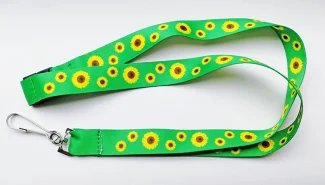Sunflower lanyards have recently become more visible around the UK. There’s been some confusion in recent times on what exactly the sunflower lanyard means, and why an individual might choose to wear it – read on to find out more!
Why and when were the lanyards introduced?
Sunflower lanyards have in fact been in use since 2016, when the accessibility team at Gatwick airport were keen to find a subtle way those with hidden disabilities could indicate this to staff. In a place that is as busy as an airport, those with invisible disabilities may require additional assistance. It is therefore important for those they interact with to be mindful of their disability, whether it be members of the public who are reminded to be patient, or a busy staff member that might not otherwise offer help.
What does the sunflower lanyard mean?
The sunflower lanyard does not provide any entitlement beyond indicating to those around you that you may need additional help due to an additional disability. As people with disabilities started to wear the lanyards to indicate a mask exemption, it led some to believe that the lanyard only indicates an individual is exempt from wearing masks in public spaces. However, the lanyard is more an indication that the person may have a hidden disability which could affect their ability to social distance or to wear a mask and helps others to understand they may need patience or assistance. It could also indicate that the person needs assistance in public spaces, such as help when shopping from shop assistants.
What are hidden disabilities?
Hidden disabilities are conditions or impairment that may affect day-to-day life, but that might not be immediately obvious to someone interacting with the individual. These can include:
- Sensory disabilities: these include blindness/low vision, hearing loss/deafness, as well as autism and sensory processing disorder.
- Cognitive impairments: these include learning difficulties and dementia
- Speech disorders: these include any condition that might affect the way an individual is able to form words, and include stuttering, apraxia and dysarthria.
- Respiratory and chronic conditions: these can include conditions such as asthma and diabetes, as well as chronic pain and sleep disorders.
Who can wear a sunflower lanyard?
There is no restriction on who can wear a sunflower lanyard. Anyone who feels they have a hidden disability that affects their everyday life, and that could mean they would benefit from more assistance, time or patience from those around them, should be encouraged to wear a sunflower lanyard if they so wish.
If I have a hidden disability, where can I get a sunflower lanyard from?
Sunflower lanyards are given to institutions and companies that are members of Hidden Disabilities Sunflower group, which means they will have sunflower lanyards at their disposal to donate to colleagues and customers for free.
We’re pleased to let you know that Imperial College Union are now part of this group, and you can collect a hidden disability sunflower lanyard from our helpdesk on the ground floor of the Union and in College Main Reception. Drop by and grab one whenever you want!
